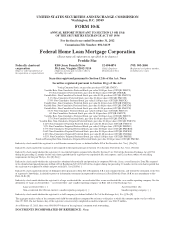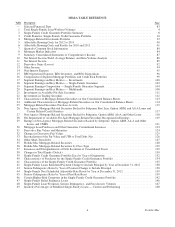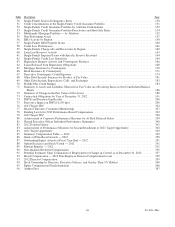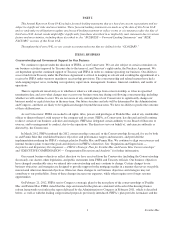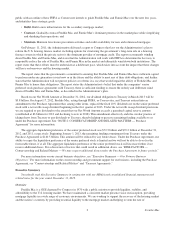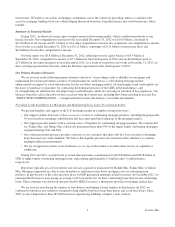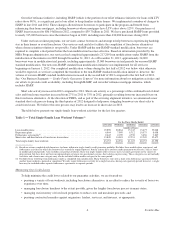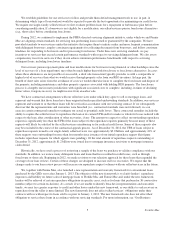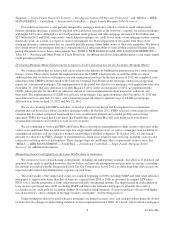Freddie Mac 2012 Annual Report Download - page 11
Download and view the complete annual report
Please find page 11 of the 2012 Freddie Mac annual report below. You can navigate through the pages in the report by either clicking on the pages listed below, or by using the keyword search tool below to find specific information within the annual report.
Segments — Single-Family Guarantee Segment —New Representation and Warranty Framework” and “MD&A — RISK
MANAGEMENT — Credit Risk — Institutional Credit Risk —Single-Family Mortgage Seller/Servicers.”
Our credit loss exposure is also partially mitigated by mortgage insurance, which is a form of credit enhancement.
Primary mortgage insurance is generally required to be purchased, typically at the borrower’s expense, for certain mortgages
with higher LTV ratios. Although we received payments under primary and other mortgage insurance of $2.0 billion and
$2.5 billion in 2012 and 2011, respectively, which helped to mitigate our credit losses, many of our mortgage insurers remain
financially weak. As a result, we expect to receive substantially less than full payment of our claims from three of our
mortgage insurance counterparties that are currently partially paying claims under orders of their state regulators. We believe
that certain other of our mortgage insurance counterparties lack sufficient ability to meet all their expected lifetime claims
paying obligations to us as those claims emerge. See “NOTE 4: MORTGAGE LOANS AND LOAN LOSS RESERVES —
Table 4.5 — Recourse and Other Forms of Credit Protection” for information about credit enhancements of our single-family
credit guarantee portfolio.
Developing Mortgage Market Enhancements in Support of a New Infrastructure for the Secondary Mortgage Market
We continue efforts that we believe will create value for the industry by building the infrastructure for a future housing
finance system. These efforts include the implementation of the UMDP, which provides us with the ability to collect
additional data that we believe will improve our risk management practices. In the first quarter of 2012, we completed a key
milestone of the UMDP with the launch of the Uniform Collateral Data Portal for the electronic submission of appraisal
reports for conventional mortgages. The implementation of the portal was effective for mortgages with application dates after
November 30, 2011 that were delivered to us after March 18, 2012. In the second quarter of 2012, we implemented the
ULDD, which provides for the efficient collection and use of consistent information about loan terms, collateral, and
borrowers. The implementation of ULDD was effective for mortgages with application dates after November 30, 2011 that
were delivered to us after July 22, 2012, with a transition period allowing for optional usage of ULDD for mortgages
delivered to us between April 23, 2012 and July 22, 2012.
We are also working with FHFA and others to develop a plan for the design and development of a securitization
platform that can be used in a future secondary mortgage market. In October 2012, FHFA released a white paper for industry
comment that described a proposed framework for a new securitization platform and a model pooling and servicing
agreement. FHFA has stated that it anticipates that Freddie Mac and Fannie Mae will each maintain its own distinct
securitization operations and continue to issue its own securities.
We are continuing to work with FHFA and Fannie Mae to develop recommendations to align certain of the terms of the
contracts we and Fannie Mae use with our respective single-family seller/servicers, as well as certain practices we follow in
managing our remedies and our respective business relationships with these companies. In October 2012, we announced,
pursuant to a directive by FHFA, changes to requirements in certain areas related to loan servicing, including a process and
criteria for evaluating servicer performance. These changes align our and Fannie Mae’s requirements in these areas. See
“MD&A — RISK MANAGEMENT — Credit Risk — Institutional Credit Risk —Single-Family Mortgage Seller/
Servicers” for additional information.
Maintaining Sound Credit Quality on the Loans We Purchase or Guarantee
We continue to focus on maintaining credit policies, including our underwriting standards, that allow us to purchase and
guarantee loans made to qualified borrowers that we believe will provide management and guarantee fee income (excluding
the amounts associated with the Temporary Payroll Tax Cut Continuation Act of 2011), over the long-term, that exceeds our
expected credit-related and administrative expenses on such loans.
The credit quality of the single-family loans we acquired beginning in 2009 (excluding HARP and other relief refinance
mortgages) is significantly better than that of loans we acquired from 2005 to 2008, as measured by original LTV ratios,
FICO scores, and the proportion of loans underwritten with fully documented income. The improvement in credit quality of
loans we have purchased since 2008 (excluding HARP and other relief refinance mortgages) is primarily the result of:
(a) changes in our credit policies, including changes in our underwriting standards; (b) fewer purchases of loans with higher
risk characteristics; and (c) changes in mortgage insurers’ and lenders’ underwriting practices.
Underwriting procedures for relief refinance mortgages are limited in many cases, and such procedures generally do not
include all of the changes in underwriting standards we have implemented since 2008. As a result, relief refinance mortgages
6Freddie Mac

